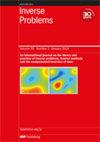Determining a parabolic system by boundary observation of its non-negative solutions with biological applications
IF 2
2区 数学
Q1 MATHEMATICS, APPLIED
引用次数: 0
Abstract
In this paper, we consider the inverse problem of determining some coefficients within a coupled nonlinear parabolic system, through boundary observation of its non-negative solutions. In the physical setup, the non-negative solutions represent certain probability densities in different contexts. We innovate the successive linearisation method by further developing a high-order variation scheme which can both ensure the positivity of the solutions and effectively tackle the nonlinear inverse problem. This enables us to establish several novel unique identifiability results for the inverse problem in a rather general setup. For a theoretical perspective, our study addresses an important topic in partial differential equation (PDE) analysis on how to characterise the function spaces generated by the products of non-positive solutions of parabolic PDEs. As a typical and practically interesting application, we apply our general results to inverse problems for ecological population models, where the positive solutions signify the population densities.通过边界观测确定抛物线系统的非负解及生物应用
在本文中,我们考虑的逆问题是,通过对非负解的边界观测,确定耦合非线性抛物线系统中的某些系数。在物理设置中,非负解代表了不同情况下的某些概率密度。我们创新了连续线性化方法,进一步开发了一种高阶变化方案,既能确保解的正向性,又能有效解决非线性逆问题。这使我们能够在一个相当普遍的设置中为逆问题建立几个新颖独特的可识别性结果。从理论角度看,我们的研究涉及偏微分方程(PDE)分析中的一个重要课题,即如何表征抛物线 PDE 非正解的乘积所生成的函数空间。作为一个典型和实际有趣的应用,我们将我们的一般结果应用于生态种群模型的逆问题,其中正解表示种群密度。
本文章由计算机程序翻译,如有差异,请以英文原文为准。
求助全文
约1分钟内获得全文
求助全文
来源期刊

Inverse Problems
数学-物理:数学物理
CiteScore
4.40
自引率
14.30%
发文量
115
审稿时长
2.3 months
期刊介绍:
An interdisciplinary journal combining mathematical and experimental papers on inverse problems with theoretical, numerical and practical approaches to their solution.
As well as applied mathematicians, physical scientists and engineers, the readership includes those working in geophysics, radar, optics, biology, acoustics, communication theory, signal processing and imaging, among others.
The emphasis is on publishing original contributions to methods of solving mathematical, physical and applied problems. To be publishable in this journal, papers must meet the highest standards of scientific quality, contain significant and original new science and should present substantial advancement in the field. Due to the broad scope of the journal, we require that authors provide sufficient introductory material to appeal to the wide readership and that articles which are not explicitly applied include a discussion of possible applications.
 求助内容:
求助内容: 应助结果提醒方式:
应助结果提醒方式:


